
Plasma-assisted cleaning of extreme UV opticsEUV-induced surface plasma chemistry of photo-active agentsThe next generation of photolithography, extreme ultraviolet (EUV) lithography, makes use of 13.5 nm radiation. The ionizing photon flux, and vacuum requirements create a challenging operating environment. Because of high EUV absorption, the optical elements must be reflective rather than transmissive and must use multilayer mirrors (MLM) of the highest quality. MLMs consist of approximately 50 Mo/Si bi-layers, stacked to form an artificial 1D Bragg crystal. Since it is expensive to manufacture such optics, the lifetime of Mo/Si multilayers is one of the critical parameters for evaluating their performance.In case of vacuum MLMs might be oxidized or contaminated by carbon. In order to develop cleaning/reduction mechanisms one should characterize the plasma chemistry induced by EUV radiation on multilayer top surface. Model systems were developed, both experimentally and theoretically, allowing contamination scaling laws to be studied. The knowledge of EUV-induced plasma formation and evolution allows plasma-induced effects and photo-induced effects to be distinguished. The best illustration of the influence of high-energy photons on cleaning mechanisms has been obtained experimentally for amorphous carbon by comparing carbon removal in a surface wave discharge plasma and an EUV-induced plasma. The results presented provide basic know-how required to adopt radiation-induced plasma surface etching for industrial multilayer mirror cleaning. It has been shown that plasma is a very effective tool for surface carbon cleaning and oxide reduction. Using EUV plasma does not require the installation of additional devices for plasma (or radical) generation, and EUV-induced cleaning could be realized without interrupting production operations. This will help to extend the lifetime of EUV optics.
Download Thesis